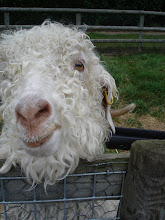The RHS gardens at Wisley run a variety of short courses as well as half day and full day training sessions. Members get a great discount and of course, free entry to the gardens any time they want. As an RHS member, I thought I'd pop along to the afternoon shrub pruning session on 13th August.
So what did I learn? Well, it is all common sense really. The golden rule is to look after your tools because, even with all the knowledge in the world, if you use blunt instruments you'll end up with poor results. You don't have to have a pair of Felco secateurs (although they do have a great range of tools to suit pretty much all requirements - and I'd love a pair if anyone feels the need to buy me an unexpected gift). After returning from the training, one of the first things I did was sit down with my old inherited secateurs, an allen key, a spanner, a screwdriver, a sharpening stone and my bike degreaser and lube. Taking them apart, sharpening the blade, cleaning the mechanism and reassembling them are all really easy steps. Look out for an entry on this topic coming soon.
On to the shrubs themselves. Bernard, my teacher, first took us through some of the most common English garden shrubs and how they behave. Buddleja, fuchsias, hydrangeas are found in most gardens and all flower off the growth formed in the same year. Therefore, you want to prune them pretty hard - cutting back most of the long stems (especially in the case of buddleja) so that they don't form ugly, long, old, woody growth. As is typical for most shrubs (and perennials for that matter) you want to regularly dead-head during the flowering season to encourage further flowering. Otherwise the dead flowers try to set seed, diverting energy away from producing more blooms. Pretty much all shrubs want to be pruned hard in early spring, i.e. late February or March. This hopefully gives the worst of the frosts time to pass before the new, young growth forms after pruning. Careful with winter flowering shrubs like forsythia. You really want to prune this straight after flowering. Leave pruning forsythia until late spring and you risk losing the next year's flowers.
Here are a few pieces of shrub-specific advice:
Buddleja davidii
Can be considered a weed I suppose. It grows everywhere, especially along the banks of the railway lines in south west London, but when in flower looks majestic and attracts so many useful insects to the garden, hence the name butterfly bush. I have always been more of a fan of the darker purple hues and so I have a Black Knight variety in my garden. This pic doesn't really illustrate what a lovely colour it is, apparently my camera simply can't handle its purple-ness!
I took a couple of cuttings earlier in the year, kept them in my open greenhouse and a couple of them even put out tiny little flowers. Donated a couple to my mum earlier today.
Hydrangea
Leave on flowers over winter to add a little frost protection. Personally I find the brown petals of the old flower heads rather unsightly but if they serve a purpose, then I guess I can live with it. When performing the early-spring pruning, you want to look for early bud growth and cut below that point. The theory here is that the early bud growth is a sign of how far the "spring energy" has risen up the stem. If you cut below the first bud growth you are forcing the shrub to put out new growth from where it has energy. Prune above the early bud growth and the shrub doesn't yet have the energy to start growing.
Philadelphus
Like other summer flowering shrubs, philadelphus flowers on growth it put out the previous year. As before, remove flowers when they start looking tired, but only if the shrub is small. I don't have a philadelphus in my garden but a couple of my neighbours do. The larger of the two would probably take a day to dead-head. Besides, I quite like the carpet of white when all the petals fall.
Wisteria
The old English country garden favourite. I have a small wisteria that I keep in a (large) pot. However, he has failed to flower reliably for the last couple of years. There are lots of theories on pruning wisteria, Bernard didn't claim to have the only method, he didn't even claim to have the best method, but he told me the method they use at Wisley and they get an abundance of amazing flowers every year.
We're assuming that the shrub is established and that you are not trying to train it into a new area. Throughout the growing season, probably worst from August onwards, the shrub will be sending out long runners looking for new places to climb. These can be taken off whenever necessary or unsightly by taking them back to 6 buds or shoots. As the leaves fall in winter, you will have a bare wisteria skeleton with each branch being six shoots long. Leave this over winter, then in February or March prune each spur by half, i.e. back to three shoots/buds.
And that's it. Of course, that isn't really IT, there is an awful lot more to successfully maintaining shrubs. If you haven't already done so, check out the RHS website as it has plenty of extremely useful advice.
All for now, see you soon...
Podcast: Why don’t we love dandelions?
4 years ago




No comments:
Post a Comment